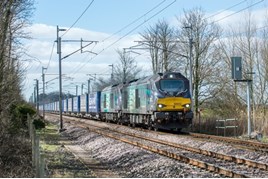Supermarkets have called for more innovation to allow them to transfer intermodal freight traffic from road to rail.
Speaking at a Multimodal seminar on ‘The Agenda for more freight by rail’ at Birmingham’s NEC on April 29, Sainsbury’s National Planning Manager Kevin Greenaway said: “If we want to use as much rail as is humanly possible, it needs to mirror what road has been doing for decades.”
He said this means rail needs to offer the same flexibility and speed of change as the road haulage industry.
“Rail is very slow to react. All of the retailers had meetings with numerous rail providers a number of years ago to look at new flows, to look at collaborative flows between all of us. It never got anywhere. It was really, really slow and really difficult to do stuff, whereas we can turn round and put new flows on the road tomorrow.
“Road is very flexible. We could bring double-deckers in and put bigger loads - cheaper loads - on road by the end of the week. All quicker than we can move stuff onto rail. And that’s the challenge.”
Greenaway said many retailers and suppliers want to use rail, but “it needs to be flexible, it needs to be cheaper, and it needs to be different. It gets quite frustrating”.
His views were shared by fellow speaker Justin Kirkhope, project manager, logistics strategy for the Co-operative, who told the seminar: “I think the harsh reality is that it comes down to cost.”
He continued: “Rail is the right thing to do from the environmental perspective, but at the end of the day we have to be a successful business - we have to remain in the business. Price and flexibility are obviously number one for us.”
Greenaway counters the environmental benefits of road: “Road has its own green agenda with dual fuel, and double-deckers, so rail can’t just sit on its own and think that the green agenda will bring everyone to rail. It needs to be an actual decent competitor with road.”
Both supermarkets agree that the key challenge with flexibility is for hauliers to provide a ‘seven-day solution’ that includes both rail and road if necessary, to provide an ‘end-to-end’ service.
Said Greenaway: “You’ve got roads that go from everywhere to everywhere. Rail is never going to be able to replace 100% of road, it just couldn’t possibly do it.
“In certain areas it does not make sense. I think we have to accept that that is always going to be the case, and actually concentrate on looking at areas where we can do it, but just accept that it’s not going to be anything like road, it just can’t be.”
- For more on this story see RAIL 774, published May 13 2015














Login to comment
Comments
No comments have been made yet.